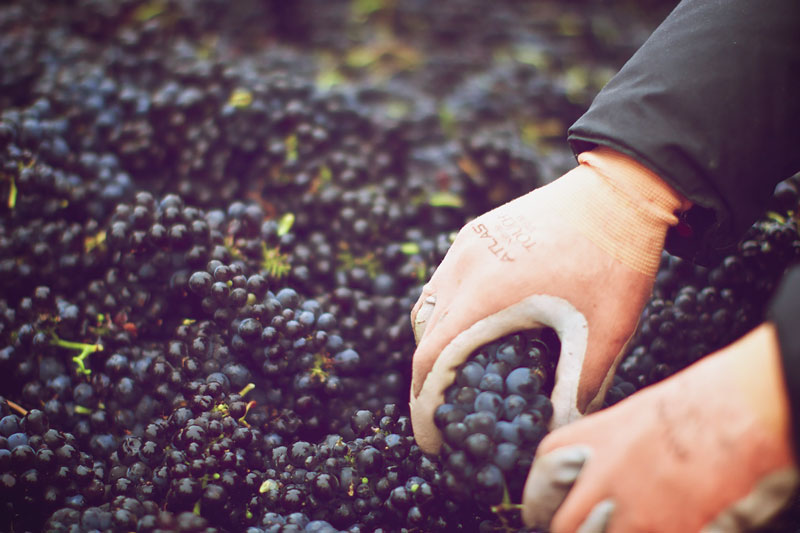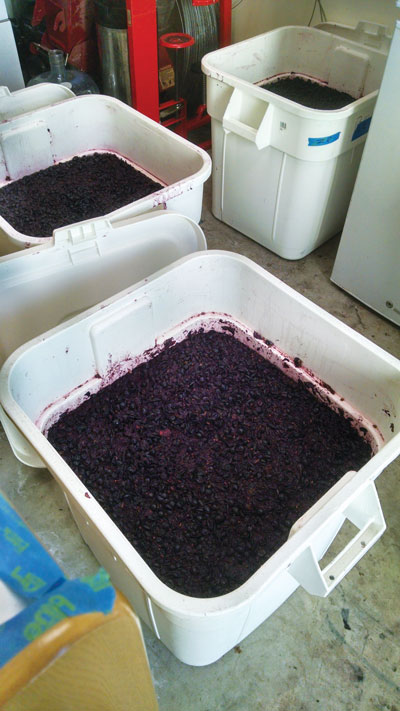Understanding the Grape
So long as I have lived in Sonoma County, California, terroir has been part of the conversation. Probably not discussed as much outside wine-growing regions, the concept is always of interest to home winemakers. I think it might get more attention if the word was easier for English speakers to say. (Merriam-Webster’s online dictionary shows the pronunciation as “ter-‘wär,” if that helps.) I have spoken about this rather flexible descriptor at conferences and I wrote a “Techniques” column about expressing terroir in white wine a couple of years ago.

Growing conditions will greatly affect what wines can be produced. Making sure the winemaker understands how to maximize their terroir’s potential comes with understanding and experience. Photo by Wes Hagen
Turning to Merriam-Webster again, their succinct definition captures the basics: “The combination of factors including soil, climate, and sunlight that gives wine grapes their distinctive character.” For grape growers and winemakers, many other factors may come into the practical application of the term.
Terroir Factors
One consideration is captured in an old expression, “grapes enjoy the sight of water.” A river, lake, or ocean near a vineyard will moderate temperature swings and bring desirable growing characteristics, whether that is warming the location as in Michigan’s Leelanau Peninsula AVA or cooling the nights in my own Petaluma Gap AVA. That term — AVA or American Viticultural Area — is connected to “terroir” also. When the Tax and Trade Bureau (TTB) of the U.S. Department of the Treasury acknowledges a designated AVA in response to a petition by grape growers, it includes the understanding that unique features affecting wine grape growth are found in that area.
Additional factors may include the slope of the vineyard site, the aspect of the land with regard to the sun’s path in the sky, or surrounding natural vegetation. Some authorities even include the people who live in a wine region and their cultural practices as influences on terroir.
Perhaps the largest and most accessible variable is simply the warmth of the growing site. For grapes, that means reference to the Winkler Scale of degree days as developed at UC-Davis. In this system, it is assumed that the daily mean temperature needs to be above 50 °F (10 °C) for grapevines to grow. The number of degrees above this threshold is multiplied by the number of days it occurs between April 1 and October 31 (in the Northern Hemisphere) and summed to create a “total degree days” value for a given vineyard site. The Winkler Scale is divided into five regions, with region 1 the coolest and region 5 the hottest.
Different varieties of red grapes are best suited for different heat regions. In cool locations like mine (Winkler II), Pinot Noir is well suited, with some Syrah and Cabernet Franc also planted here. In a very warm region, like Winkler IV (think of Lodi, California), robust red varieties like Zinfandel and Petite Sirah grow well. Sonoma County is large and geographically diverse, including some 19 AVAs. I have had the opportunity to make wine from grapes grown in several of those, giving me direct experience with expressing the different terroirs, and occasionally working against the natural conditions.
Scenario 1: Petaluma Gap
In my first growing seasons with my Pinot Noir vineyard, I accidently over-emphasized some aspects of my cool-climate zone. During the summer, I did not thin or hedge my vines, resulting in excessive vegetative growth that shaded the fruit. Some expected characteristics of cool-climate Pinot Noir — notes of herbs and baking spices — came out exaggerated in those vintages. Once I learned to better manage the sunlight exposure, I again missed the mark a couple of times by trying to reach the sort of high Brix numbers that represent warm-climate wines.
For the past several years, I have settled in with the terroir that I have, keeping the fruiting zone open and well ventilated and dropping excess clusters at veraison. I harvest at a moderate 23 to 24 °Brix, tasting the fruit and assessing the seeds each time I check the sugar. My wine is higher in acid than many red wines, but to balance that I apply MLF (malolactic fermentation) using a bacteria strain that does not produce buttery notes. I age my wine in a French medium-plus toast barrel, but only for a few months. These days I get crisp, fruity, light-bodied Pinot Noir with pleasant background notes of earth, cola, and baking spices. Although I could decide to add sugar and chemically deacidify in pursuit of a bigger, bolder wine, I am very happy to stay in balance with my terroir.
Scenario 2: Bennett Valley
Another example when terroir had a prominent influence was a group project at the home winemaking store where I used to be a partner, The Beverage People in Santa Rosa, California. A commercial winegrower had bought an existing vineyard parcel in the Bennett Valley AVA in Sonoma County. Several varieties were planted, including Merlot. Bennett Valley is a cooler region at the northern end of the larger Sonoma Valley, which is generally much warmer.
The Winkler Scale is divided into five regions, with region 1 the coolest and region 5 the hottest.
Taking possession of his land in mid-summer, the new owner offered to sell Merlot fruit to home winemakers. Partnering with some coworkers, I visited the vineyard, looked over (and tasted) the ripening fruit, and arranged to buy a few hundred pounds. Everything went well, harvest was routine, and we divided up the grapes to make our separate wines. Unfortunately, all of them showed the green bell pepper pyrazine character that Bordeaux varieties sometimes exhibit when insufficiently ripened. Brix had been fine, so we were dealing with a problem of physiological maturity (or immaturity as the case may be).
The grower explained that by the time he took possession, the crop load looked too heavy on the Merlot vines. He went through and dropped fruit to try to bring the crop into balance in his cool AVA and I agreed upon tasting the grapes that it seemed to have worked. Unfortunately, the fruit did not fully recover from being “overcropped” earlier in the season, which lead to the pyrazines. It is certainly possible to grow excellent Merlot in Bennett Valley, but the cool terroir must be accommodated or the cooler climate will be expressed in the wine.
Scenario 3: Sonoma Valley
Another team project with my coworkers turned out with a much more positive expression of terroir. A group of us agreed to buy the entire crop of a hobby vineyard growing Syrah and Cabernet Sauvignon in the heart of the Sonoma Valley AVA — much warmer than Bennett Valley. The owner/grower was experienced, the vineyard looked great, and the region is excellent for those varietals. Oddly, though, when our group had the opportunity to taste a Cabernet from a previous vintage from that vineyard, is seemed a bit thin and herbaceous. We decided the results must be from either a single bad-weather year or some aspect of winemaking decisions, because everything about the vineyard looked good.
We asked for harvest to wait until both varieties reached 25 °Brix, then picked and divided up the entire crop of several hundred pounds. The wines turned out very well, with one red blend even earning a gold medal in the California State Fair Home Wine Competition. We had a group tasting of the various versions at the shop and everyone was happy with their results. In this case, the warmer vineyard site and pushing for full maturity did exactly what we hoped for.
Scenario 4: Dry Creek Valley

Dry Creek Valley is another warm Sonoma County AVA. Some 50 wineries are found in the AVA and more than 150 produce Dry Creek AVA wines. I was given the opportunity to buy some grapes from a small vineyard there that was a mixed planting of Zinfandel and Petite Sirah. The vineyard manager is a friend of mine who worked as a consultant to small-scale growers. Along with keeping the vines healthy, managing the crop load, and overseeing the harvest, he sold the fruit for the owner if it was not already under contract. He estimated that the “field blend” that he would pick from this Dry Creek plot would be about 10% Petite Sirah and 90% Zinfandel. When the morning arrived for me to go pick up the grapes, grape quality appeared excellent, just as I expected. Both varieties are well suited to this warmer area of our county and I was pleased to be making my first field blend.
On a whim, my winemaking friends and I decided to set aside about 100 lbs. (45 kg) of crushed fruit to soak for a single carboy of rosé. The grapes were fully ripe at about 26 °Brix and a titratable acid level of about 5.5 g/L (0.55%). The red field blend wine was delicious and exactly expressed the warm, dry terroir of its origin. Unfortunately, so did the rosé. It wasn’t bad (and we drank all of it while it was still young), but it was very dark from even a few hours on the skins. It could easily be mistaken for a light red wine and was lower in acidity than rosé balance usually calls for.
Given the terroir, this crop was perfect for reds, but would have had to be managed differently if the crop was intended for rosé production. Because full ripeness would not be as essential, the vines could have carried a heavier crop in this scenario. So, either less fruit could be dropped at veraison, or if planning for rosé early enough, more buds could have been left at the previous winter’s pruning. Harvest would have been earlier, at perhaps 22 or 23 °Brix. For winemaking, we could have gone directly from the crusher/destemmer to the press for a lighter color. We could have added tartaric acid to make up for the relatively lower level typical in this terroir.
Scenario 5: Petaluma Gap (Deviated)
Finally, I have one more terroir example from my own vineyard. Years ago, I was serving some of my estate Pinot Noir to my older brother, John. I was bragging about having grown the grapes and made the wine. While he was happy to drink what I poured for him, he noted that my wine lacked “oomph.” He was not wrong, of course. It is cool-climate Pinot Noir with high acid, modest color, lower alcohol, and some herbaceous notes.
The next vintage, I resolved to make a Pinot Noir with oomph for him. At the end of fermentation, I transferred five gallons (19 L) of just-finished Pinot Noir to a 6-gallon (23-L) carboy and added enough 68 °Brix Zinfandel canned grape concentrate to reach an alcohol level of about 18% upon refermentation. Naturally, this presented challenging conditions in a wine that already had about 13% alcohol — something like working with a stuck high-sugar fermentation. I used the excellent restart yeast Uvaferm 43, carefully rehydrated a double dose with rehydration nutrients, and put the carboy under a desk in my kitchen where it could stay warm. It took three or four weeks, but it eventually finished fermenting. It was dark, strong, and even showed a hint of sweetness. When I gave him a few bottles for Christmas the following year, John agreed that I had contradicted my terroir and had achieved “oomph.”





